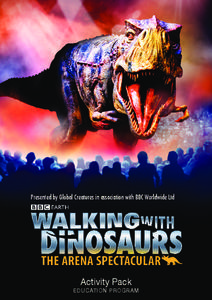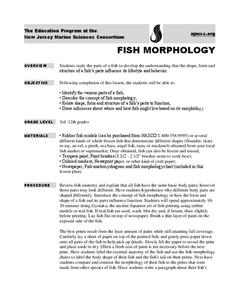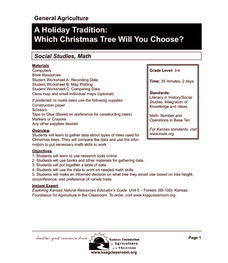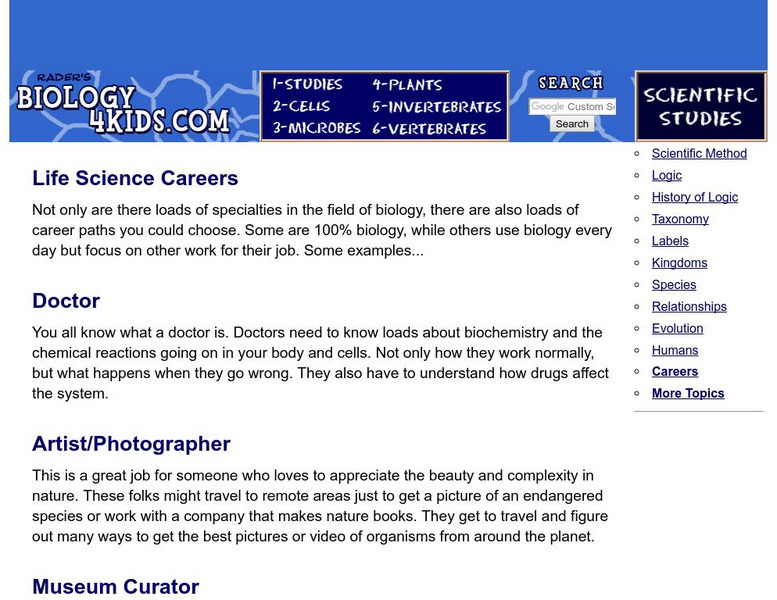BBC
Walking with Dinosaurs
Breath new life into your class's study of dinosaurs with this extensive collection of materials. Offering everything from a printable T-rex mask, word searches, and connect-the-dots activities to informational handouts, hands-on...
Consortium for Ocean Science Exploration and Engagement (COSEE)
Fish Morphology
Life comes in all different shapes and sizes, and fish are no exception. Here, young scientists create fish prints as they learn how specific characteristics allow different species to survive in their particular habitats.
Curated OER
Simple Machines Worksheet
Simplify students' lives with this physical science note-taking guide. From inclined planes to moveable pulleys, this resource supports young scientists with defining each type of simple machine while identifying their mechanical...
Wilderness Classroom
Ocean Life
Our oceans are composed of many complex relationships. Young oceanographers explore relationships between organisms, understand the world ocean's currents, and discover the effects of water pollution and how it behaves. There are...
National Wildlife Federation
Penguin Fun Facts
What's black and white and can dive up to 1,800 feet under water? That's right, penguins! Learn this and many other amazing facts about these unique birds with this handy reference sheet.
Minnesota Literacy Council
Scientific Method
Here is a resource with a descriptive approach to explaining the scientific method. It's simple, but effective for both introduction and reinforcement of this concept.
New York State Department of Environmental Conservation
Adaptations – Designs for Survival
What's the difference between behavioral adaptations and physical adaptations? Learn about the various ways that organisms adapt to their environment with a worksheet about the creatures of the Hudson River.
Cornell University
Insect IPM
Find out the characteristics that makes a bug an insect with a workbook designed to inform scholars about the crawly creatures that live around us. Scholars complete an ant-themed word search, answer questions using a solution key,...
Agriculture in the Classroom
A Holiday Tradition: Which Christmas Tree Will You Choose?
Different varieties of Christmas trees provide an interesting way to combine social studies, science, math, and technology. Class members not only research the history of the Christmas tree holiday tradition, they compare and...
Project Oceanography
Fish Shape
A fish's size, fins, and shape can tell us a lot about them! Learners explore fish anatomy to see how species use camouflage, scales, shape, and coloration to survive. The lesson includes advanced vocabulary such as fusiform shape,...
Laboratory for Atmospheric and Space Physics
Looking to the Future
New Horizons set forth on a mission to Pluto in 2006. Ten years later, the spacecraft is still on its way. Here, enthusiastic scholars predict what they will be like—likes, dislikes, hobbies, etc.—when New Horizons arrives at its...
Wilderness Classroom
Pollution
Educate scholars on pollution—air, water, and land—with a series of lessons that begin with a thorough explanation of each type. Learners then take part in three activities to reinforce the importance of reducing pollution. They...
Mary Pope Osborne, Classroom Adventures Program
Mummies in the Morning Egyptian pyramids, hieroglyphics
Visit the Magic Treehouse and take your class on a trip through time with a reading of the children's book Mummies in the Morning. Using the story to spark an investigation into Egyptian culture, this literature unit engages...
Curated OER
The Planet Mars
In this worksheet on the planet Mars, students look at a picture of the planet and read accompanying facts, along with a brief paragraph.
Curated OER
The Earth
In this earth fact worksheet, students look at a picture of the planet earth and read a list of accompanying facts, along with a brief paragraph.
Biology 4 kids
Biology4 Kids: Life Science Careers
This short summary explores a few careers in the life science area.
CK-12 Foundation
Ck 12: Earth Science: Characteristics and Origins of Life Study Guide
A general overview of the origin and characteristics of life.
Science Struck
Science Struck: Facts About the Marine Biome
Describes the characteristics of the marine biome, the plants and animals that live in each of the four ocean zones, coral reefs and estuaries, the climate of the marine biome, and the marine food web.
Science Struck
Science Struck: Examples of Pulleys in Daily Life
Learn how pulleys work and their many uses in everyday life, industry, recreation, and other activities. Includes many pictures of pulleys and pulley systems.
Channel 4 Learning
Channel 4 Learning: Science Essentials: Life Cycles
Learn about the life cycles of plants and animals then demonstrate what you know with activities, a quiz, and related resources.
Science Struck
Science Struck: 10 Nasa Inventions You Might Be Using Every Day
Many things invented by NASA are used in everyday life. Some of the most widely used inventions are described here.
Environmental Education for Kids
Eek!: Community Action & Citizen Science: Pearl Louise Pohl
Pearl Louise Pohl was a gifted teacher who believed strongly in environmental conservation and spent her life dedicated to environmental causes.
Science Struck
Science Struck: Information About the Marine Biome
Describes the characteristics of the marine biome and the plants and animals that live there.
Science Struck
Science Struck: Life Cycle of a Tornado
Describes the three stages of a tornado's life cycle.
Other popular searches
- 4th Grade Life Science
- Life Science Inquiry
- Life Science Vertebrates
- Life Science Experiments
- K 2 Life Science
- Life Science on Cells
- Life Science Lesson Plans
- Grade 4 Life Science
- Life Science Report Topic
- Australia Life Science
- The Life Science
- Life Science Lessons
















